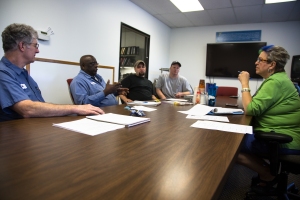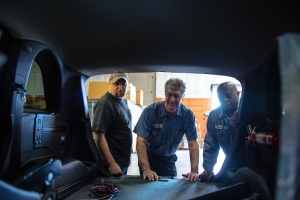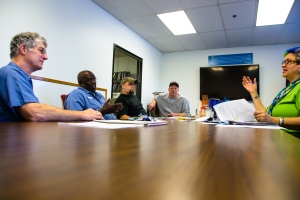Fleet and Radio Communication teams patch things up—in more ways than one
 When two teams work closely together for a long time, relations sometimes become challenging as staff and technologies change. This in turn can affect productivity, quality, efficiency, and customer service.
When two teams work closely together for a long time, relations sometimes become challenging as staff and technologies change. This in turn can affect productivity, quality, efficiency, and customer service.
That’s exactly what happened between the Department of Transportation’s Fleet Administration and King County Information Technology’s Radio Communication Services (RCS).
Both RCS and Fleet work on County vehicles, including all Sheriff’s Office vehicles. RCS is primarily responsible for installing radios and hooking up lighting, and Fleet is responsible for maintaining the vehicles and installing additional add-ons required by the Sheriff’s Office.
The two groups used to work together in the same workshop. When they had to move to separate locations, communication between them became more difficult. Not only that, new technologies blurred the lines between job functions. Changing customer needs added even more stress to the working relationship.
“It used to be clear what work Fleet did and what work was done by RCS.” explained Stephen Jacoby, a RCS technician. “Fleet installed the lights and light bar on the vehicles and RCS wired everything up to the siren and light controller that was installed by RCS.”
 When the vehicle options changed from the manufacturers, it became harder to figure out who should be doing what. “There was a lot of disagreement about division of duties. Grievances were filed, and filed grievances were heading to binding arbitration,” said Bill Kehoe, Chief Information Officer, Department of Technology. “The situation was taking too much time and attention away from the work that had to be done for the customer.”
When the vehicle options changed from the manufacturers, it became harder to figure out who should be doing what. “There was a lot of disagreement about division of duties. Grievances were filed, and filed grievances were heading to binding arbitration,” said Bill Kehoe, Chief Information Officer, Department of Technology. “The situation was taking too much time and attention away from the work that had to be done for the customer.”
After nearly 10 years of this, something had to change.
Management from both agencies acknowledged that each work group had legitimate concerns and fears about job security. They decided that using tools to focus on continuous improvement and conflict resolution was critical for the teams’ success. They turned to County resources at the Human Resources Division and brought in a facilitator to work with the groups.
In 2011, a “Process Improvement Team Charter” was developed and actively supported by Team Sponsors, Kehoe and Laurie Brown, Deputy Director, Department of Transportation. The facilitator, Chuck Davis, went to work with front-line employees from both shops to look at the production process the two groups went through.
“When I am brought in, my approach often is to look at the process rather than address the conflict,” Davis said. “We looked at the areas where the tensions were—from the time the Sheriff’s car comes in to the time it leaves— and tried to make recommendations about that.”
After scrutinizing the process, Fleet and RCS developed a set of recommendations for improvements. Fleet technician Bruce Barnes said that while crafting the recommendations, both groups became aware of their lack of communication.
“We never talked to each other. We’d see them drop cars off and we’d maybe talk a little, but we really didn’t talk about what the problems were between the groups,” Barnes said.
 One solution that emerged from the process improvement work was the installation of phones in both workshops so the groups’ technicians could call each other directly instead of going through management. Another was monthly meetings.
One solution that emerged from the process improvement work was the installation of phones in both workshops so the groups’ technicians could call each other directly instead of going through management. Another was monthly meetings.
“We now hold meetings where the technicians come for the first hour and the supervisors come the last half hour,” said DOT’s Fleet Coordinator Maria Van Horn, who facilitates the meetings. “Now people can express their opinions and not feel like they’re going to be slammed for it later.”
The two groups also developed a wiring matrix to make sure the teams use the same color wire for the same job, removing any confusion when work is passed from one team to another.
As working relations improved at the technician level, the team recognized communication gaps at levels “above their paygrade.” They felt comfortable enough to raise their concerns to management, hoping the positive results they were experiencing could be realized at other levels.
Their concerns were heard by management who took steps to improve collaboration among supervisory staff by engaging the County’s Alternative Dispute Resolution (ADR) program.
“The use of the County’s talented ADR folks was a game-changer. They came in and helped with some difficult and uncomfortable conversations. What resulted was interdepartmental collaboration at the supervisory level and the employees knew management had begun really walking their talk,” Brown said.
While the groups still may not always initially see eye to eye, the tools are in place to resolve any problem quickly, before it gets too big.
“I’ve seen big improvements between us and Fleet. It’s not perfect, but it’s a lot better than it used to be,” Jacoby said. “It has definitely been a good experience with working with other departments.”
Barnes said the resolution process brought to his attention the importance of relationships in the workplace.
“Now that we’ve gotten to know each other more it provides a more human aspect,” Barnes said. “Team building and getting the job done involves relationships—not just the technical part of it.”



Ten years of this dysfunction? Really? Why wasn’t it addressed much sooner?
Great question, Paige, and we should have been more clear in the article.
The dysfunction was addressed a number of times over the years. Things would somewhat improve for a period of time then would slowly but surely return to a state of dysfunction to the point of negatively impacting customer service. It wasn’t until we involved front-line employees in addressing the problem that we experienced sustainable improvement. We learned we needed to work on the problems in a deep and holistic manner. “Management” alone couldn’t make a comprehensive real change…the employee teams had to work it and own it. And their respective Unions needed to support the collaboration. I’m a true believer in the power of employee engagement and Labor-Management cooperation. The best part is that, in the end, the taxpayers win.
So should we have realized this earlier and used this approach earlier? Yes. However, learning how to do things differently isn’t easy work. What’s important is we’re learning. And we wanted to share what we learned in case it is helpful to other work groups facing similar challenges.
This is a great article. Of the many lessons learned here, including the need for continuous communication, conflict resolution, and great KC resources such as ADR, it seems that one of the most important lesson was around the origin of the initial problem. The two work groups used to be in the same facility, which allowed for easy communication. Then the groups were separated, which created silos and a gulf in communications.
Does this sound familiar? Indeed we are looking at technical groups being separated now as part of the current realignment (example: IT PMs and IT BAs are moving away from customer bases to be homed on floor 6/7). In general, I’d argue for keeping technical groups who work on the same systems together where possible. I can see times when it might make sense to separate them, however generally speaking it does not.